The Chicago Plan Commission has approved the 8.1-acre North Union megadevelopment in the Near North Side. Generally bounded by the CTA Brown Line tracks and W Oak Street, W Chestnut Street, and N Wells Street, the North Union site will spread across eight acres. Planned by JDL Development, the project site is currently occupied by one or two story buildings, parking lots and an athletic field, all part of the Moody Bible Institute campus. The entire plan reserves 9.4 acres for Moody Bible Institute while turning over the remaining 8.1 acres over to JDL.
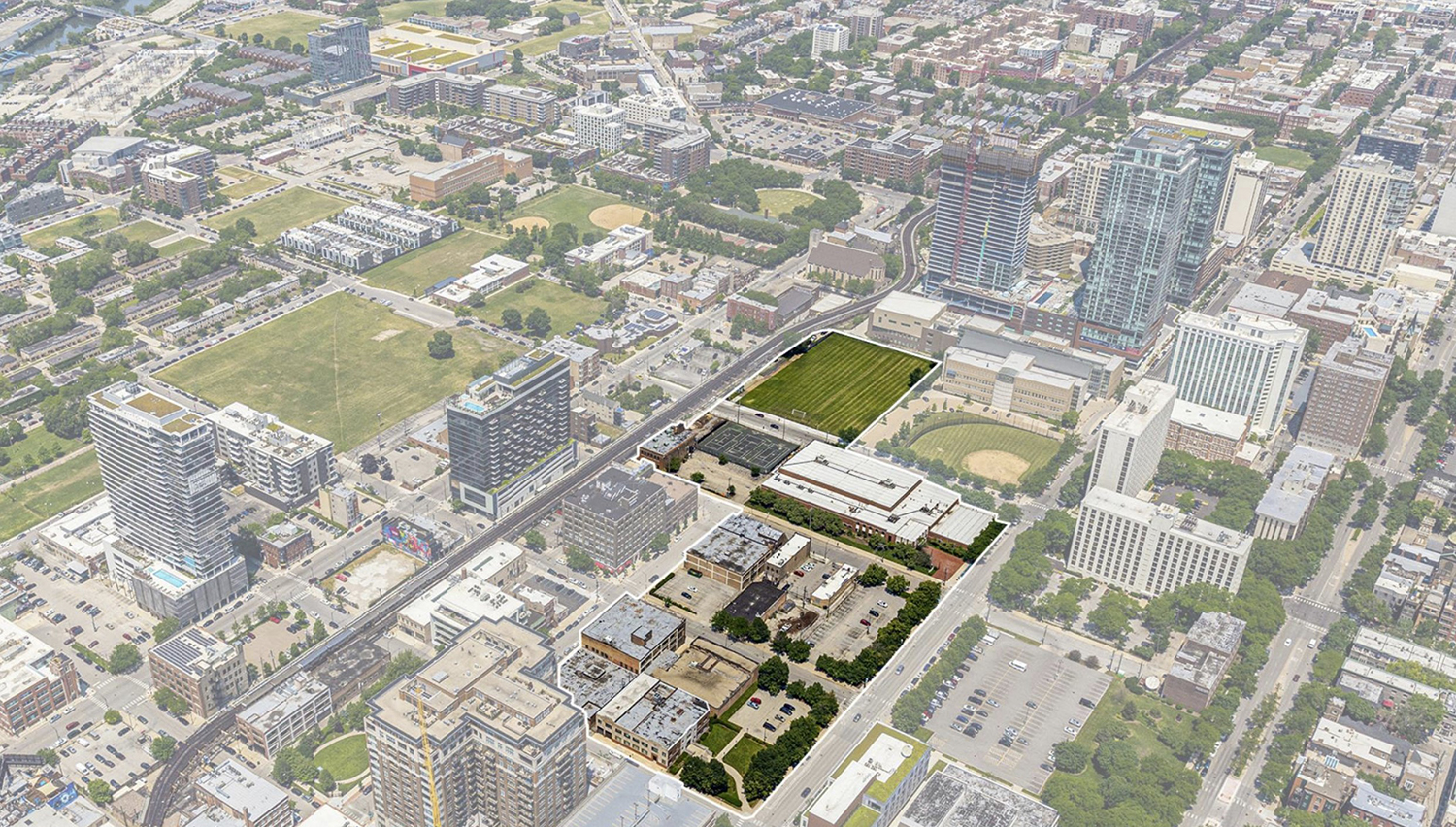
Aerial View of North Union Site. Image by Hartshorne Plunkard Architecture
The planned development will rezone the property from Institutional Planned Development 477 and C1-3 to DX-5 and ultimately a new Planned Development. While there are currently no plans for the Moody Bible portion, the designation will allow for the ability to construct up to 580,000 square feet of space with 1,372 dwelling units.
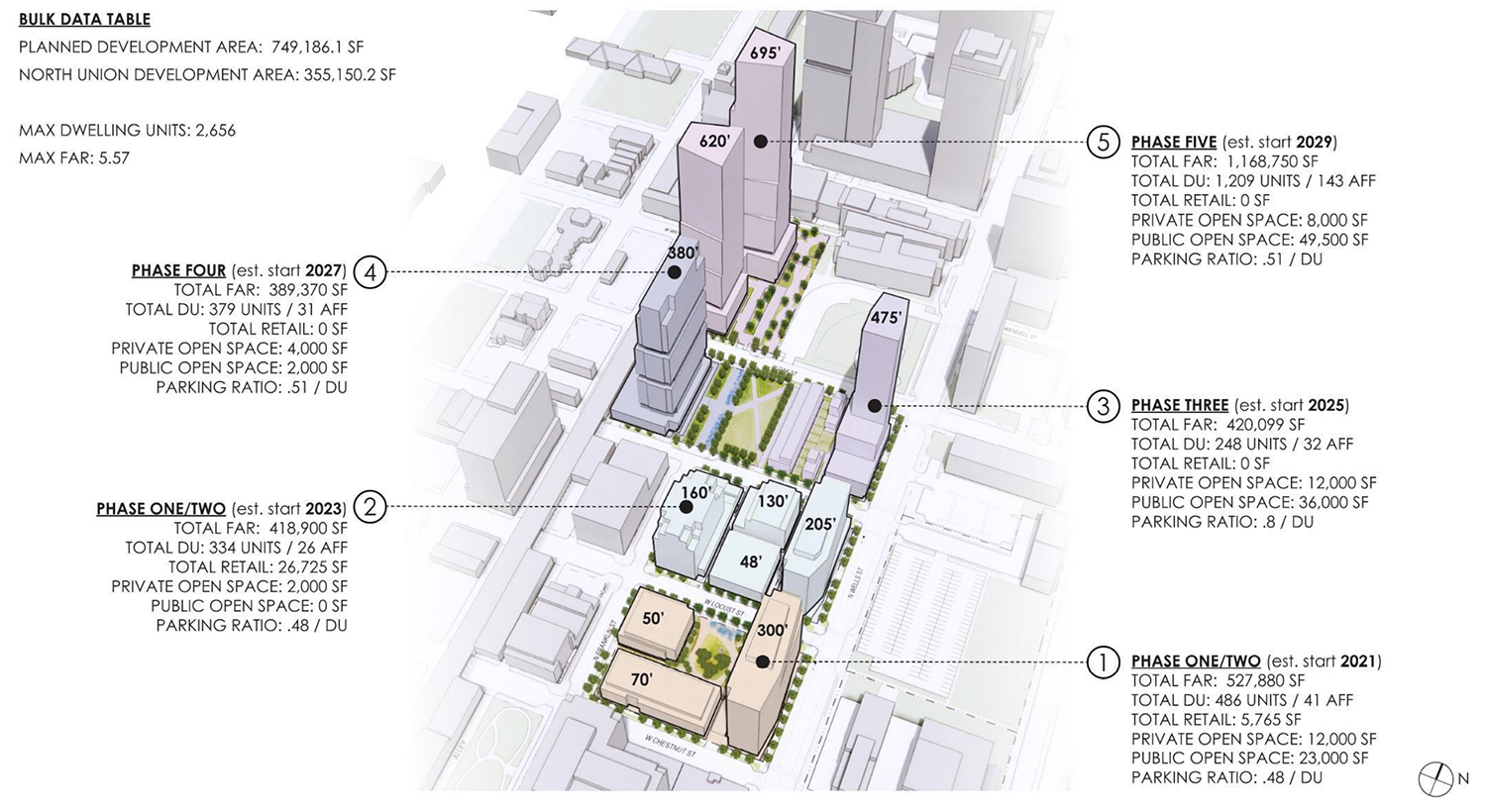
Phased Axon Diagram of North Union. Diagram by Hartshorne Plunkard Architecture
Expected to be constructed in five phases, the entire scope of development will encompass approximately 2.9 million square feet, producing 2,656 residential units in addition to active retail space. The design team for the project includes Hartshorne Plunkard Architecture, Latent Design, and Omni Workshop. 2.5 acres of the property will be designed and implemented as public open space, offering green space to residents and the surrounding community. Parking will be based on an approximately one space per two unit ratio, with the majority of parking moved underground.
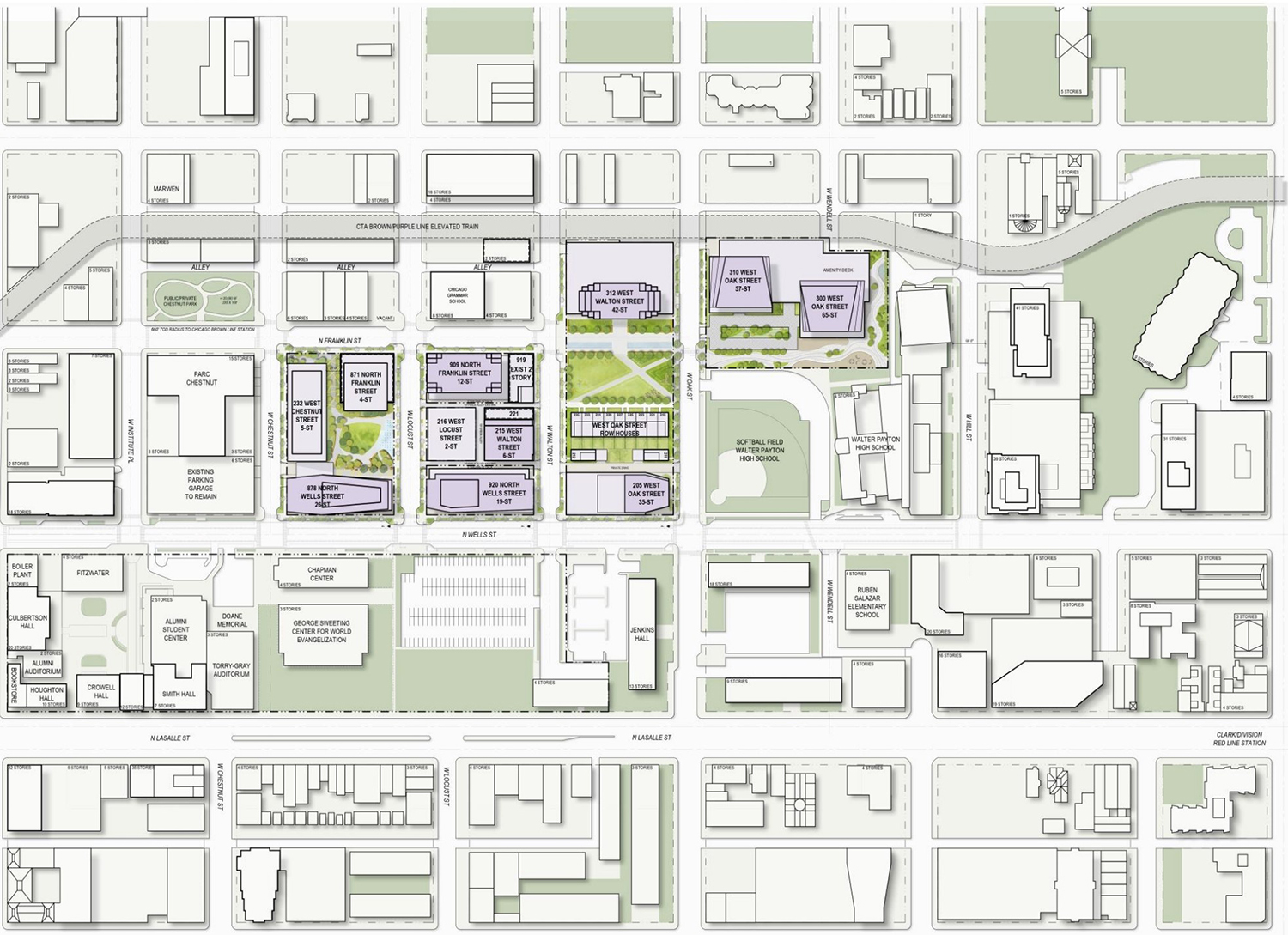
Site Plan for North Union. Drawing by Hartshorne Plunkard Architecture
After the two community meetings and engagement with city officials, modifications have been made to the overall proposal. Public open space has been increased between W Walton Street and W Oak Street, as well as north of W Oak Street. Loading and parking access has been shifted and optimized for all of the buildings. Three curb cuts have been removed in the process. Public alley widths have been increased and parking podiums have been moved almost entirely underground. Design changes have been made to the buildings, including alterations to the massing and sculpting of the towers to respond to a wind impact study performed. Single-family homes on W Walton Street have been removed.
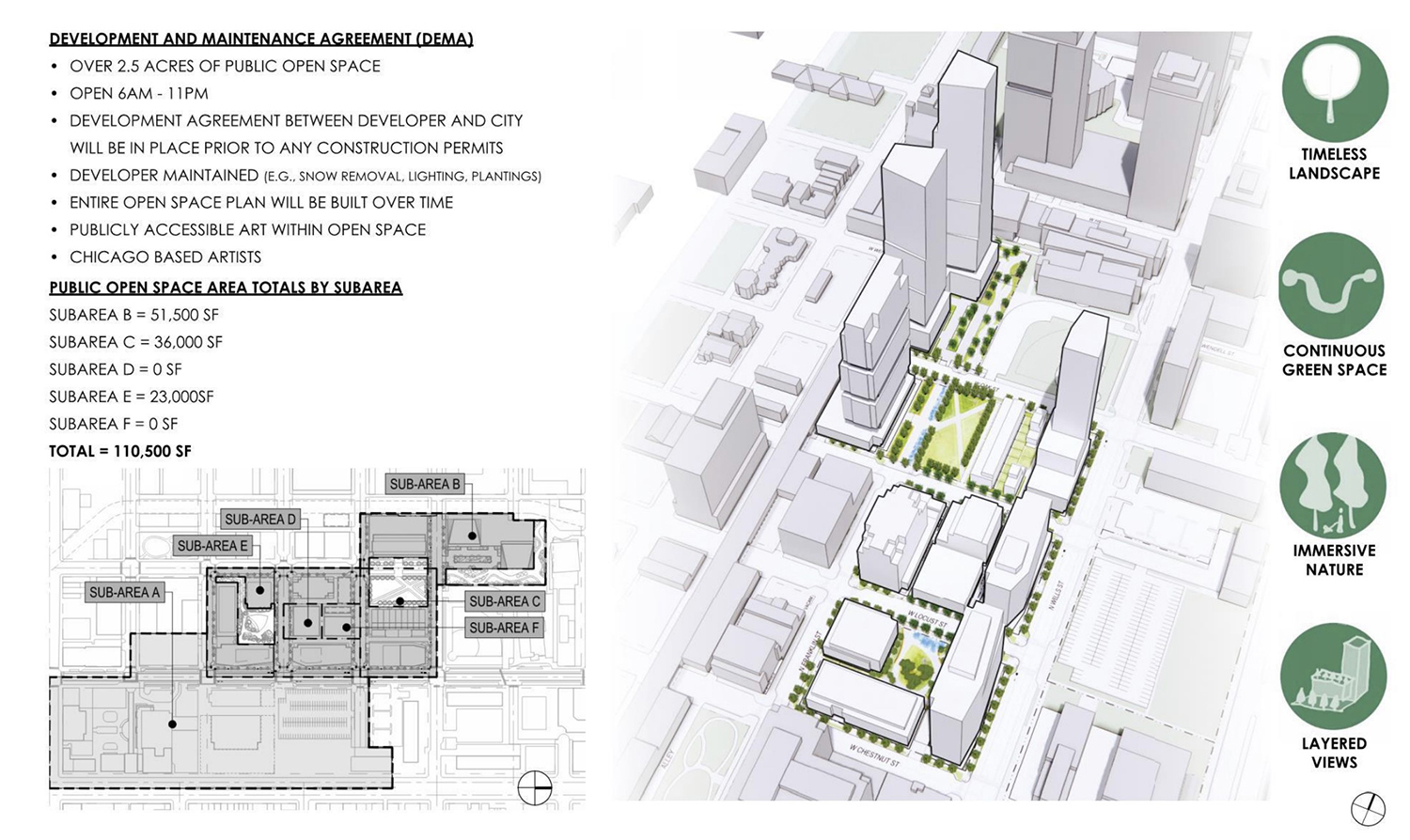
Site Open Space Plan for North Union. Diagram by Hartshorne Plunkard Architecture
The majority of park space will be located within three of the five phases. The developer will make an agreement with the city about the maintenance and operation of the public park space. Public art will be featured across the entire development. In phase one, the park space will open to W Locust Street while being surrounded on three sides by new construction. Phase three will hold the largest green space out of the allotted open space for the project. The park will include a great lawn with grade level changes for interest, children play areas, and a mid-block connection. Phase five will hold the outdoor space for a dog park, including separate areas for large and small dogs. The green space will create an open buffer between the new development and Walter Payton College Preparatory High School.
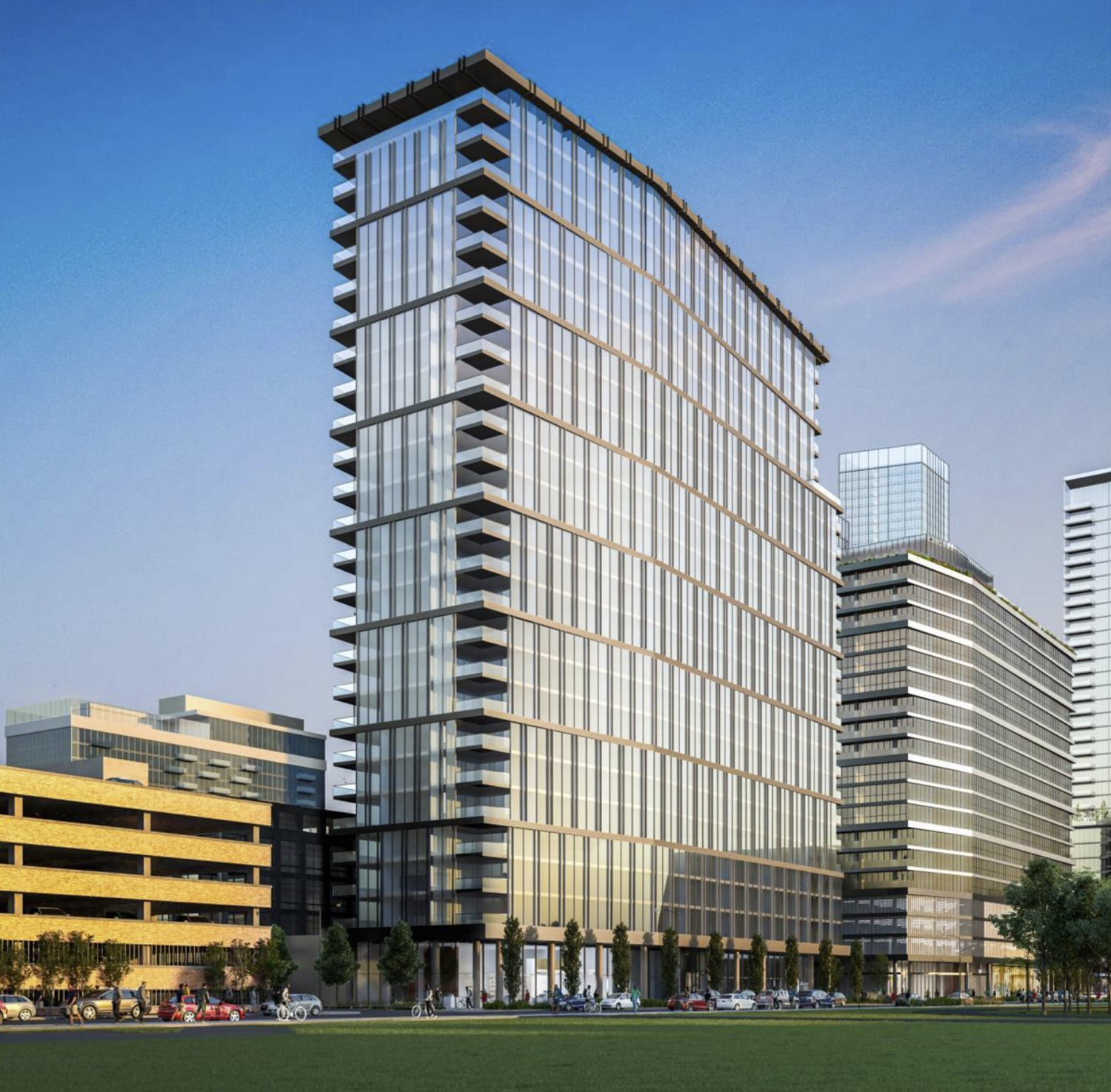
878 N Wells Street at North Union. Rendering by Hartshorne Plunkard Architecture
Expected to begin in 2021, phase one of the development will include three buildings and expansive open space. The first tower will be 878 N Wells Street, rising 279 feet tall over 25 stories. Sculpted to angle away from N Wells Street to create a sculptural street wall, the tower will hold 428 units and 5,600 square feet of ground floor retail space. Retail will face N Wells Street and the open green space. Terraces are integrated into the corners of the building, while the massing of the tower setbacks on its northern elevation. The facade creates a rhythm of vertical projected mullions interrupted by horizontal bands every three floors.
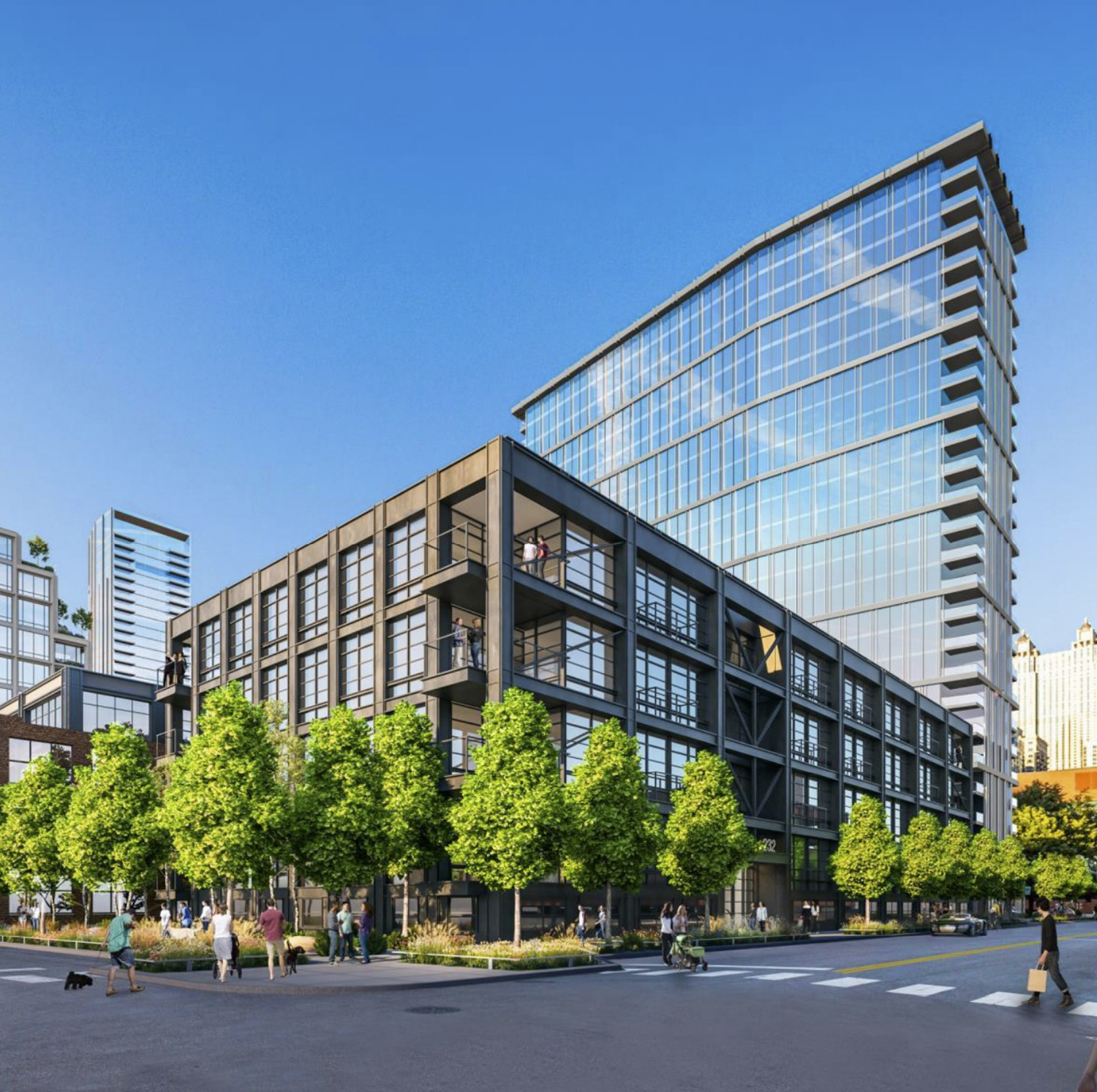
232 W Chestnut Street at North Union. Rendering by Hartshorne Plunkard Architecture
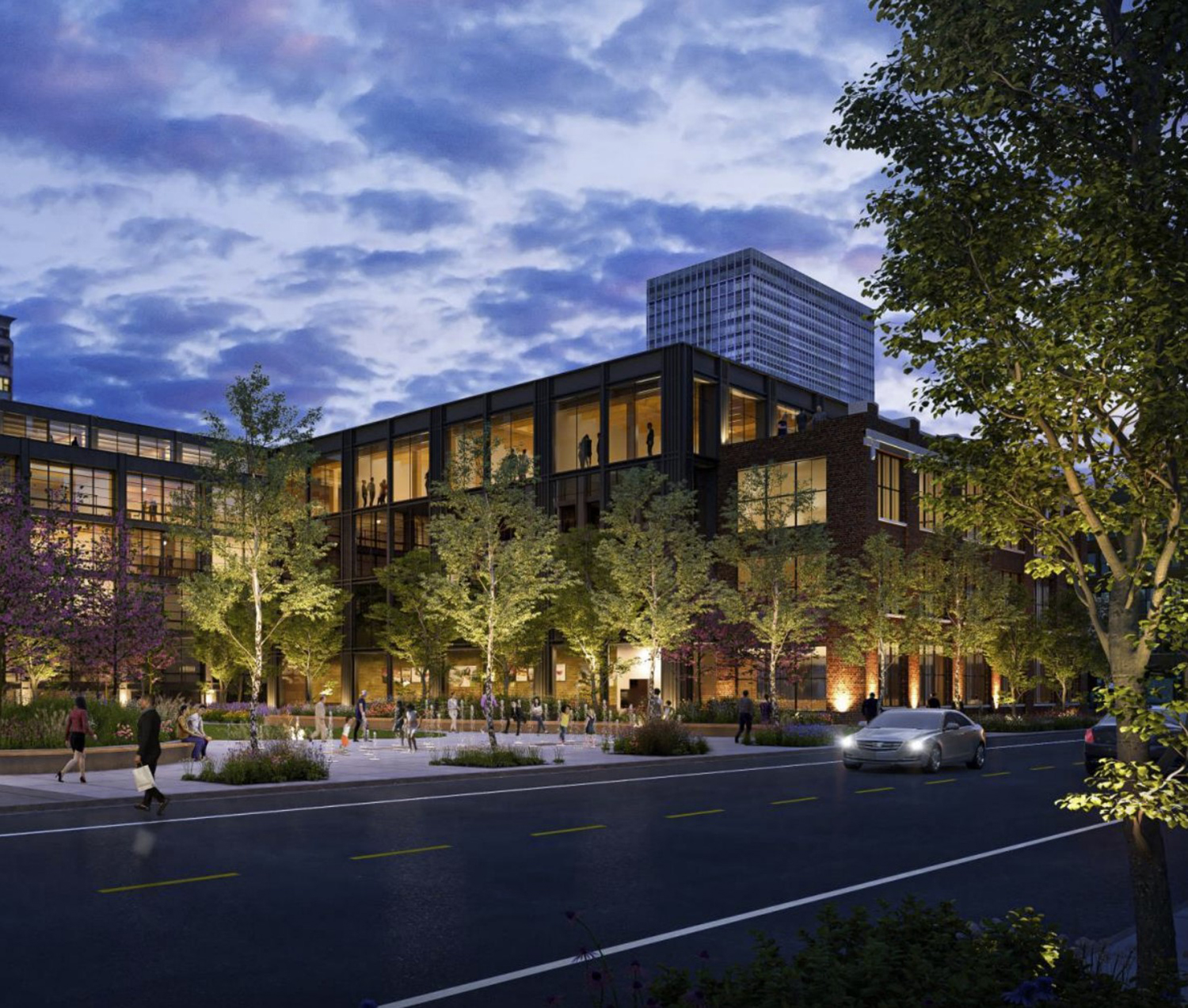
871 N Franklin Street at North Union. Rendering by Hartshorne Plunkard Architecture
232 W Chestnut Street, the next structure in this phase, will be a five-story structure rising 70 feet in height. Holding 35 residential units, the building will utilize a mass-timber structure and be clad in a steel structure facade. Residences will be larger in size and have corner balconies. The final building of the first phase will be 871 N Franklin Street, an existing building that comprises four floors that rise 50 feet tall. Formerly the Nealy Printing Company, the masonry and limestone structure will be adaptively reused with a glass addition creating a fifth floor.

920 N Wells Street at North Union. Rendering by Hartshorne Plunkard Architecture
Phase two, expected to begin in 2023, will comprise multiple structures without any public open space. The first tower will be 920 N Wells Street, rising 218 feet in height over 19 floors. The massing features the angled facades that create a varied street wall along N Wells Street. The northern and southern facades feature balconies that alternate every three floors. The east edifice has a subtle change in the projection of horizontal bands, creating variety in shadow and reflections. 216 W Locust Street will be the replacement athletic facility for the exclusive use of Moody Bible Institute. It will hold athletic training facilities and a basketball court, with a facade that is clad in a series of transparent and fritted glass panels.

909 N Franklin Street at North Union. Rendering by Hartshorne Plunkard Architecture
Next in phase two, 909 N Franklin Street will comprise 12 floors, standing 160 feet tall. Retail space will occupy the ground floor, while 100 residential units will be located on the upper floors. The building will step back from the corners as it rises, creating corner terraces for the residences. The fenestration pattern is reminiscent of the historic gallery loft buildings of the area, using glazing in a punched opening manner framed by cast stone as a contemporary interpretation of terracotta.
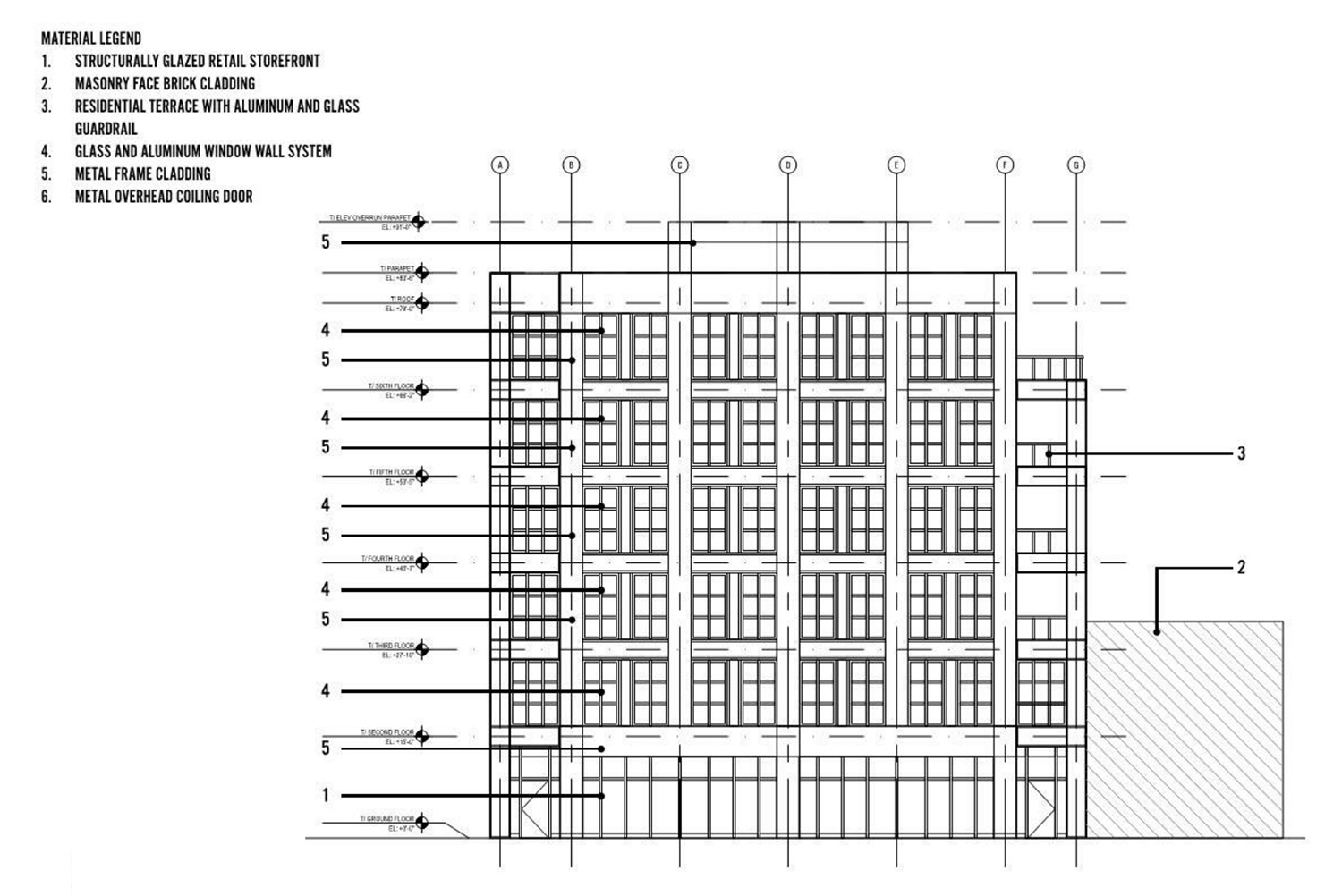
North Elevation for 215 W Walton Street at North Union. Drawing by Hartshorne Plunkard Architecture
215 W Walton Street will be the final new building, encompassing six levels and expected to rise 91 feet. The massing is intended to remain low to respond to surrounding historic structures and is clad with metal and brick masonry. 221 W Walton Street is a current former firehouse and is orange-rated. Under the plan, it will be converted into a single-family home with character defining features being restored and preserved. 919 N Franklin Street, an existing two-story building, will include retail and office space, with the structure undergoing the rehabilitation of its existing brick detailing and the replacement of existing windows.
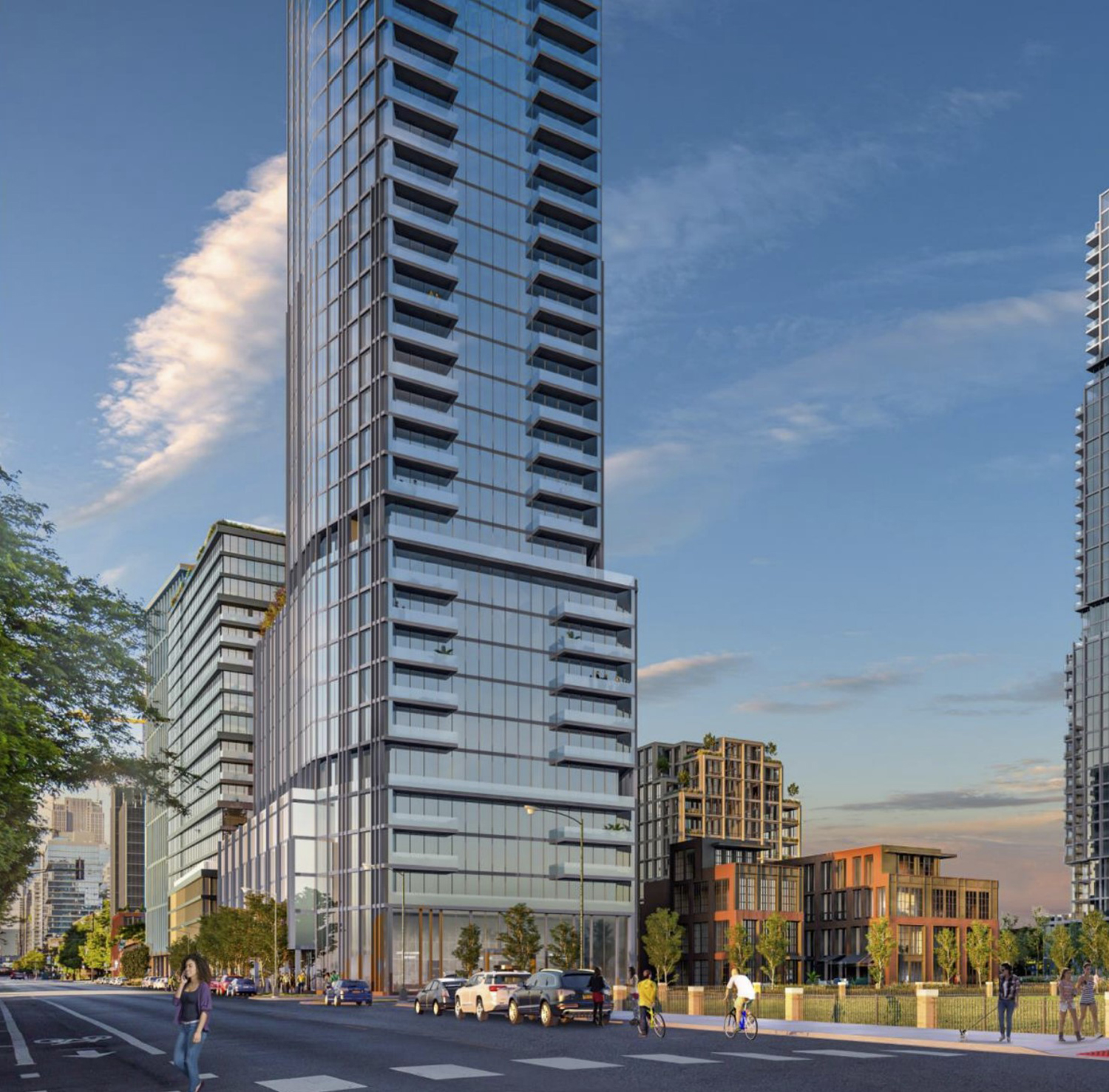
205 W Oak Street at North Union. Rendering by Hartshorne Plunkard Architecture
Phase three is planned to begin in 2025, producing two new construction buildings and the central park space for the entire development. 205 W Oak Street will be the main tower for this phase, rising 38 stories. Measuring 408 feet, it will hold 237 residential units as well as 6,500 square feet of retail space facing N Wells Street. The asymmetrical massing of the structure focuses the density to the northern end of the footprint, shaping the volume with the angled facade like the other two buildings along N Wells Street. The ground floor is inset to create more pedestrian space while a series of projecting mullions taper as they rise on the facade. A private drive on the interior of the site provides access to the underground parking. The height of this tower was reduced after the parking podium was removed. Balconies will be located on the northern elevation.
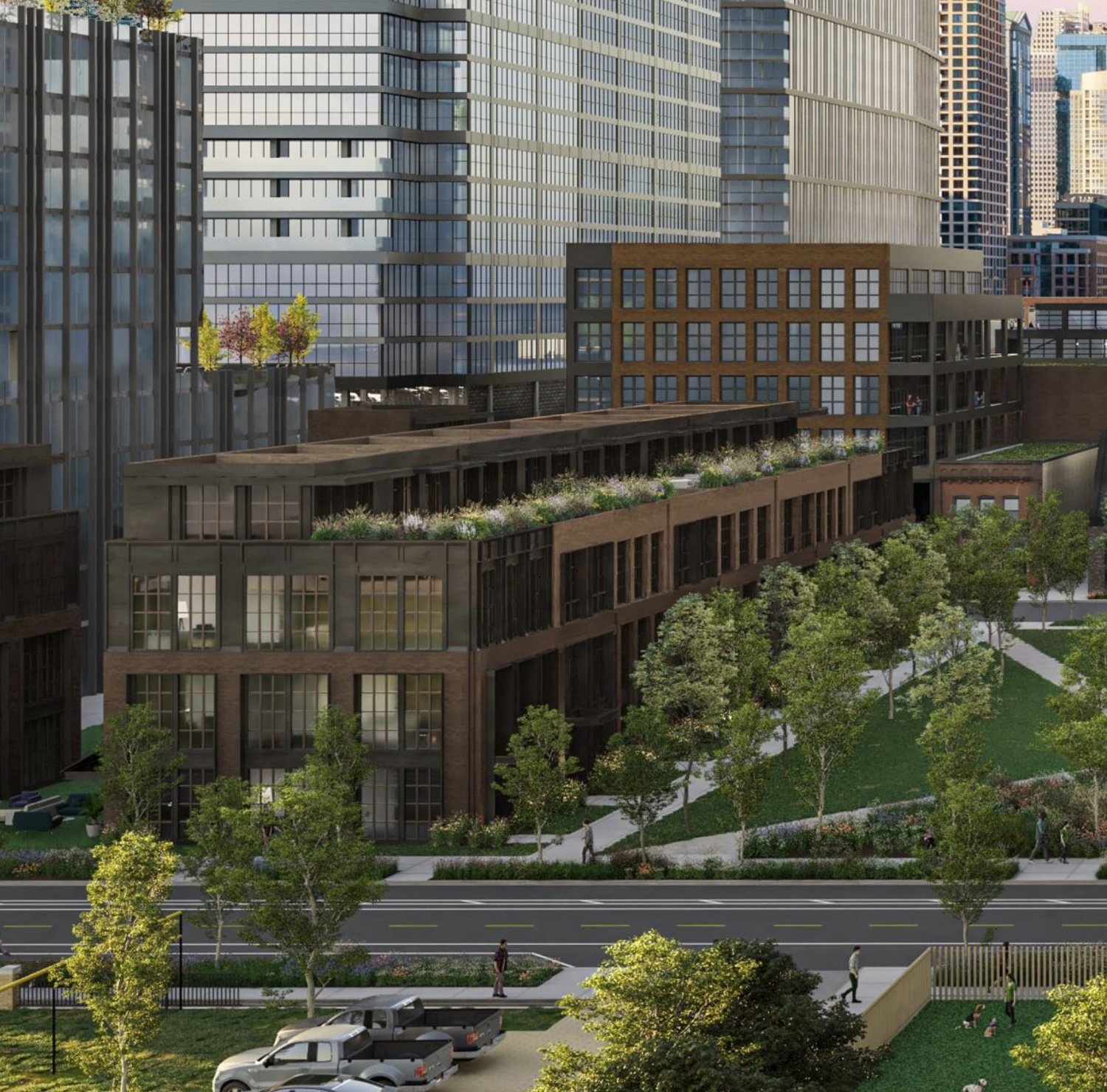
235-305 W Oak Street at North Union. Rendering by Hartshorne Plunkard Architecture
A set of nine row houses will span from W Walton Street to W Oak Street. Addressed as 235-305 W Oak Street, the home will be four floors tall and have private front and rear yards. The design utilizes contemporary massing details while using classical proportions that relate to the surrounding context. Masonry is used on the lower floors, while the upper floors use a metal and glass design.
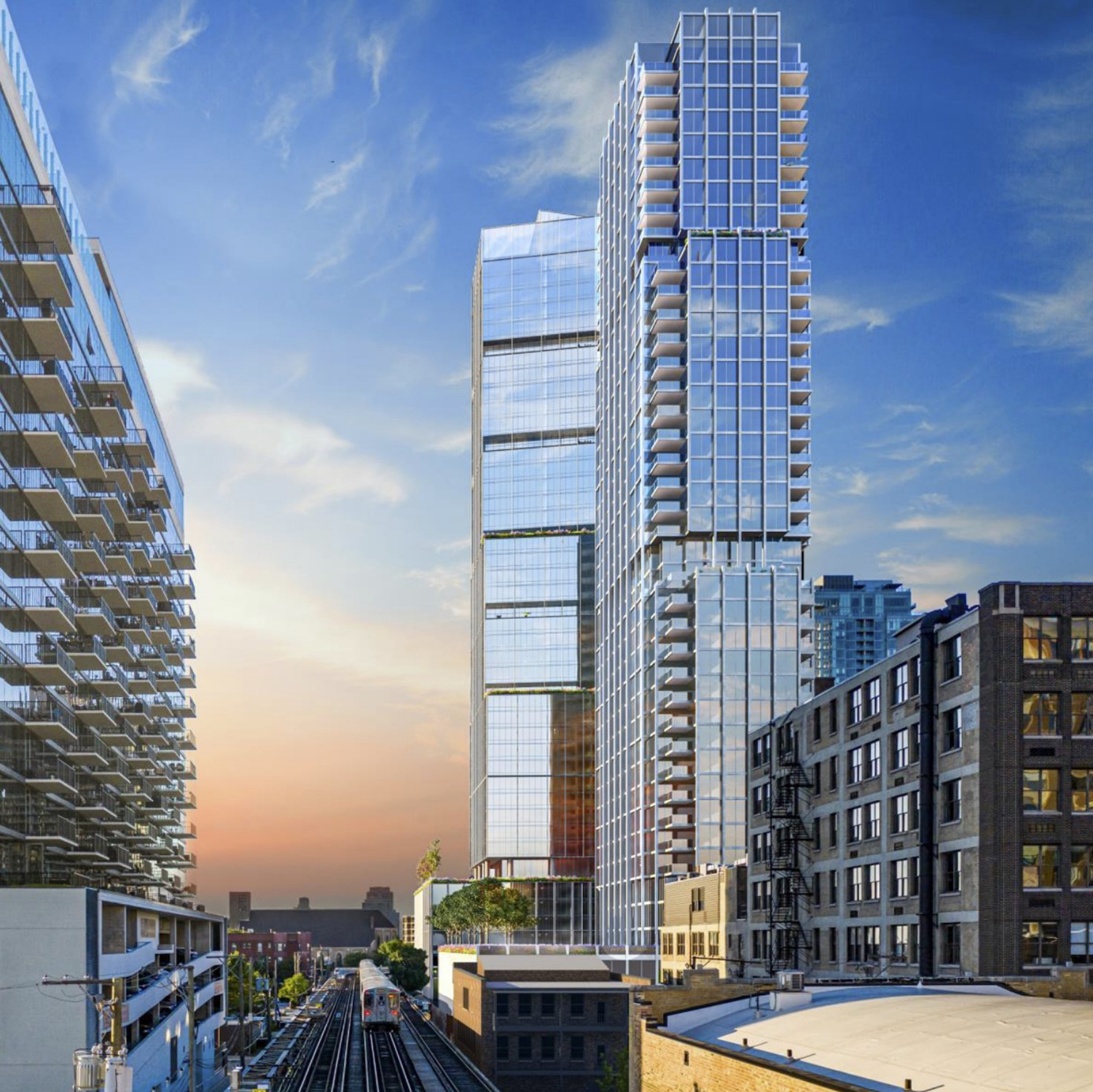
312 W Walton Street at North Union. Rendering by Hartshorne Plunkard Architecture
Expected to begin in 2027, phase four will include only a single tower. Rising 435 feet, 312 W Walton Street will be a fully residential building with no retail space. 379 residences will occupy the 37-story structure. The symmetrical form setbacks as it rises, featuring corner balconies. Inset floors within the vertical portion of the building allow for the reduction of downdraft winds to improve the pedestrian experience. Y-bracing at the base gives way to vertical ribs that stretch the entire height of the structure. Parking is located adjacent to the CTA L tracks.
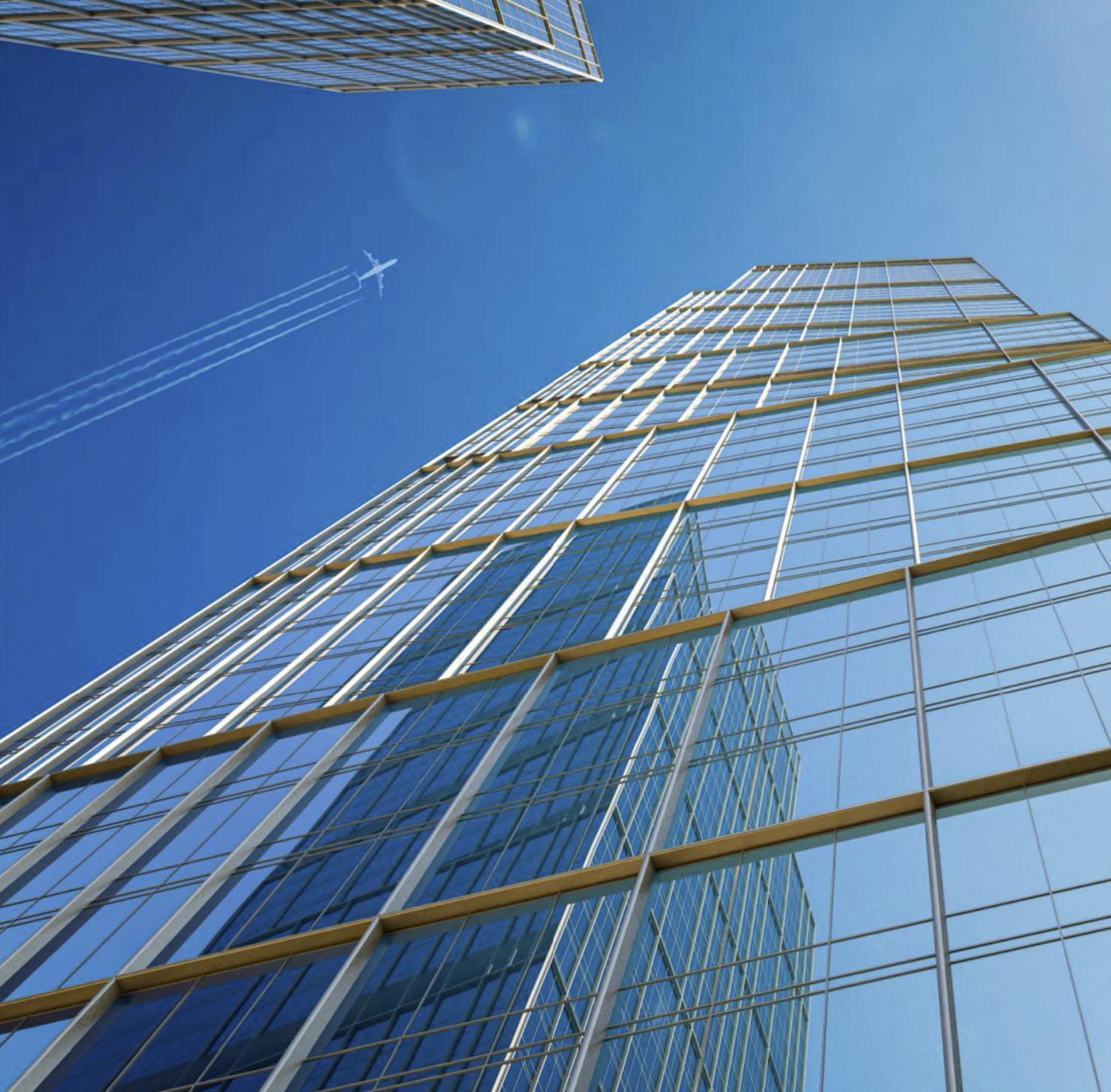
300 and 310 W Oak Street at North Union. Rendering by Hartshorne Plunkard Architecture
Phase five will be the terminus of the project, producing the tallest buildings, expected to begin in 2029. 300 W Oak Street will rise 56 stories, measuring 685 feet tall. 310 W Oak Street will be slightly shorter, encompassing 47 floors that rise to a peak of 574 feet. They will hold 667 residential units and 542 dwellings, respectively. Retail space will front W Oak Street with the remainder of the ground floor including residential lobbies for each tower, bike parking, and various mechanical spaces. A common parking podium along the CTA L tracks will be screened.
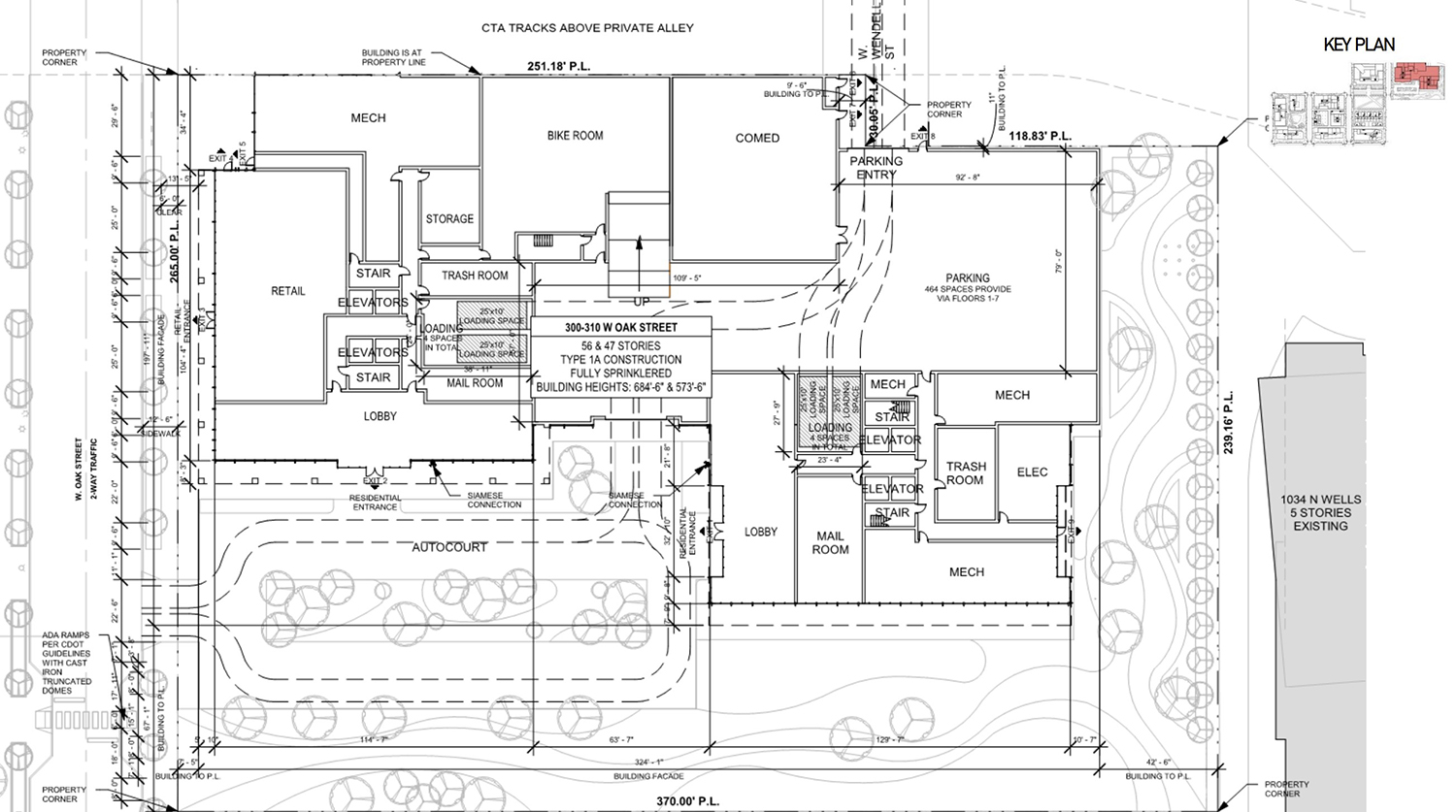
Site Plan for 300 and 310 W Oak Street at North Union. Drawing by Hartshorne Plunkard Architecture
The towers will rise from the podium, each in a rhombus shape that will inset as it rises to create terraces and maximize views. The facade will use reflective glass and projecting vertical mullions that are intersected by horizontal bands at every five floors. A central auto court will provide access for pickup and dropoff to the lobbies, while parking will be accessed from W Wendell Street. The massing of both towers were carved near the ground in reaction to wind studies in an effort to minimize downdraft conditions at the ground level. A dog park measuring approximately one half acre will surround the podium, offering green space on the parcel.

Circulation Plan for North Union. Drawing by Hartshorne Plunkard Architecture
The circulation of the site will use the existing street grid within the boundaries of the property. There will be no curb cuts along N Wells Street to preserve and protect the existing bike lane. Curb cuts will be made on the side streets, with vehicle entrances placed away from pedestrian entrances or bike lanes. The development will add new traffic signals, improve signal timing, and add crosswalks for pedestrian safety.
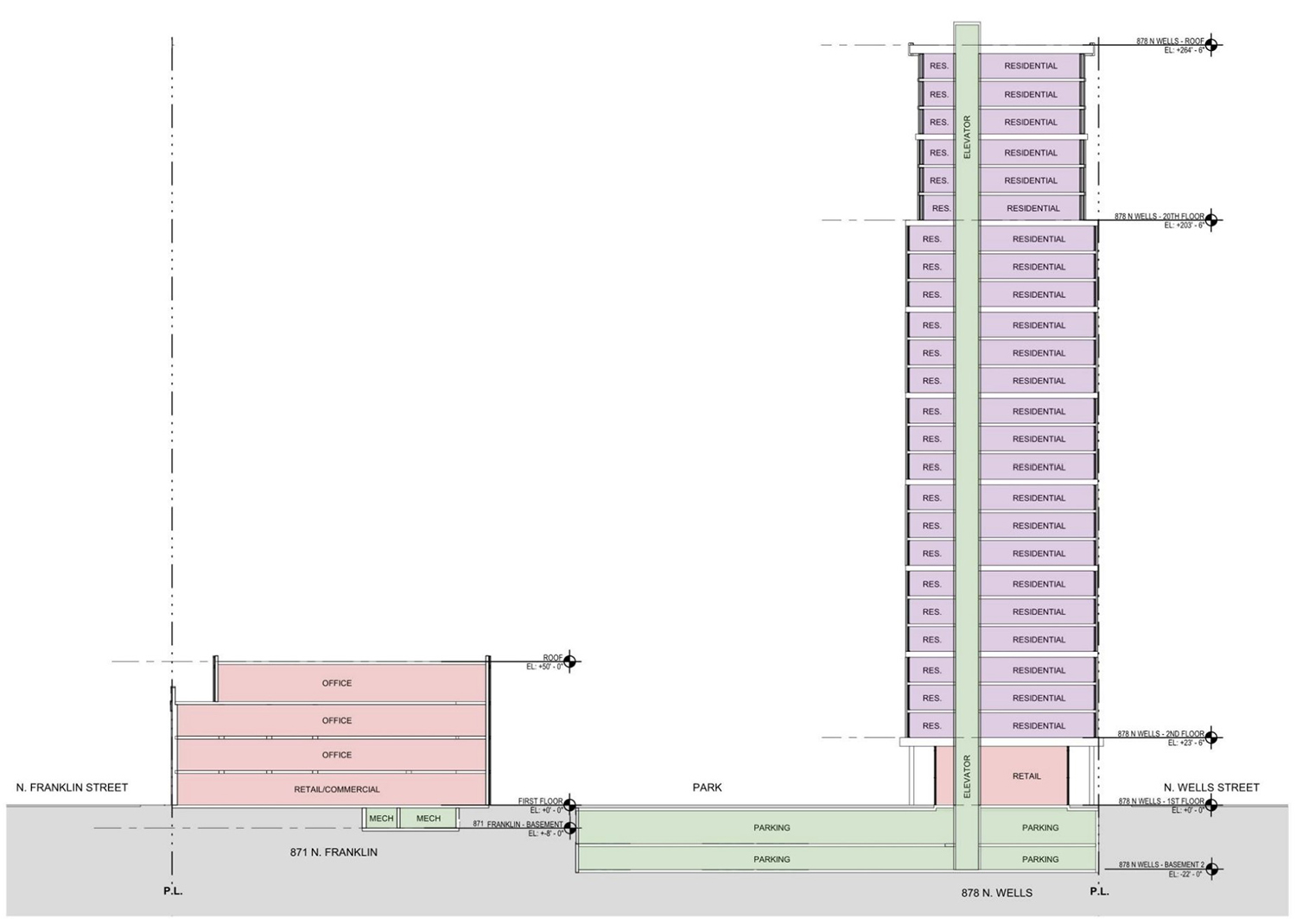
Site Section of Phase 1 at North Union. Drawing by Hartshorne Plunkard Architecture
Sustainability will be achieved in all of the buildings through multiple strategies. This includes exceeding the energy code by 10%, implementing working landscapes and tree planting, green roofs, indoor water use reduction, the parcel’s proximity to transit, bikeshare sponsorship, bike parking, EV charging stations, CTA digital displays, and 80% construction waste diversion. The entire development will seek LEED Neighborhood Development status and utilize bird friendly design strategies on several edifices.
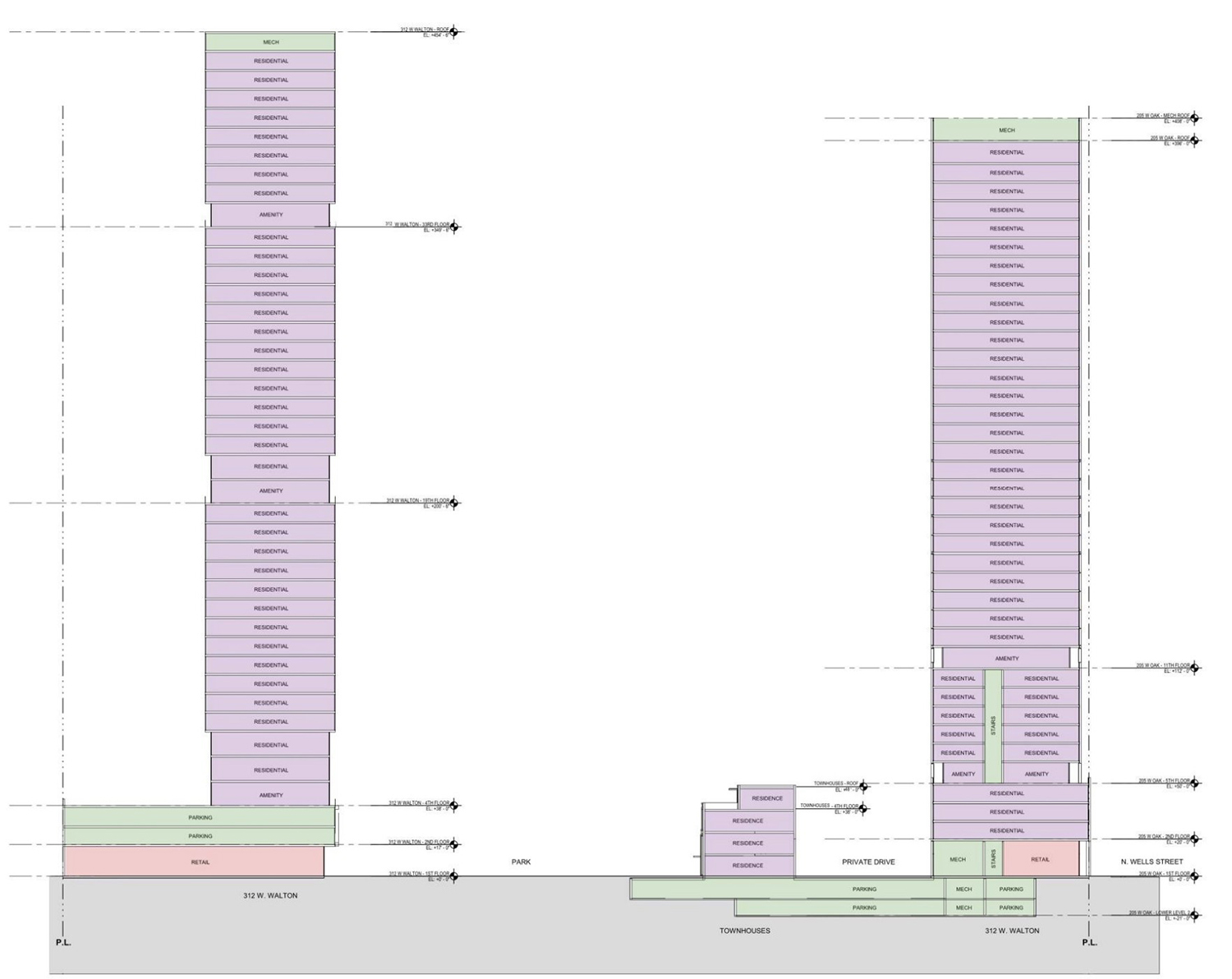
Site Section of Phase 3 and 4 at North Union. Drawing by Hartshorne Plunkard Architecture
266 affordable units are required for the entire scope of the development. 236 of these are expected to be provided on site, dispersed amongst all of the buildings. The mix will include 28 three bedroom units, 53 two-bedroom residences, 140 one bed dwellings, and 15 studios. 118 units, 88 above the remaining requirement will be provided off-site or paid in lieu for a total of $22 million.

Aerial View of North Union. Image by Hartshorne Plunkard Architecture
The development will be receiving no public funding and is expected to cost $1.3 billion. With Chicago Plan Commission approval, the proposal will go before the Zoning Committee and receive a final approval from the Chicago City Council. JDL Development is hoping to begin construction on the first building in 2021, either from the designated phase one or from phase two.
Subscribe to YIMBY’s daily e-mail
Follow YIMBYgram for real-time photo updates
Like YIMBY on Facebook
Follow YIMBY’s Twitter for the latest in YIMBYnews

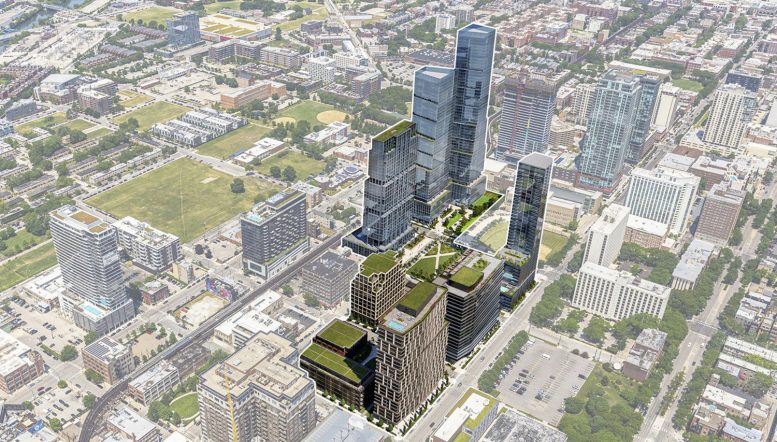
Love that most of the parking is underground not wasting above ground space for car storage. Also love how much the development tries to encourage non-car transportation.
Chicago leadership needs to aggressively get back to making non-car transit as attractive, safe and more pervasive so private developments don’t bear the costs of feeling forced into absorbing the failure of US transportation policy over the last 60 years through going all in on cars.
I never really looked into this project in detail before. Everything looks great. It looks like the tallest towers are view terminators for Clybourn. Am I seeing this right?
I agree Jim but this project is just so dense, that north tower is obscenely out of place being that tall and will block all the great views of the skyline from the near north neighborhood. I know views arent protected but what makes Chicago so unique is the long vistas between towers IMHO. Also, the L can not handle the capacity as it is, there is no way to support this kind of density going forward without a new L line to run under Orleans to the Loop, it’s been talked about since the 70s and is desperately needed to relieve the Brown and Red lines assuming transit goes back to precovid levels. Anyone living here will be walking or sitting in traffic jams, they are not getting a spot on the train.
We should keep Chicago quaint so nobody is ever inconvenienced in traffic jams, crowded trains or has to suffer the shame of peering into neighboring buildings rather than sweeping vistas as far as the eye can see. Growth is inevitable and there’s a trade-off for wanting to live downtown in a global city known for skyscrapers.
These exact types of stagnation inducing sentiments have either completely lost Chicago many would-be transformational developments or significantly reduced scale, density and ambition of others. This ethos has become far too common today. You know a building being “obscenely tall” and “out of place” in its area is totally subjective and to make progress you need to pass thresholds to redefine what is possible. Hopefully these towers are the catalyst for future developments that seek to surpass these limits.
Traffic jams, overcrowding, more cars, more people with garbage on the streets and more crime, just what we need in this area as it is already overflowing. This is all about GREED by the city and JDL.